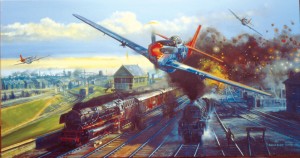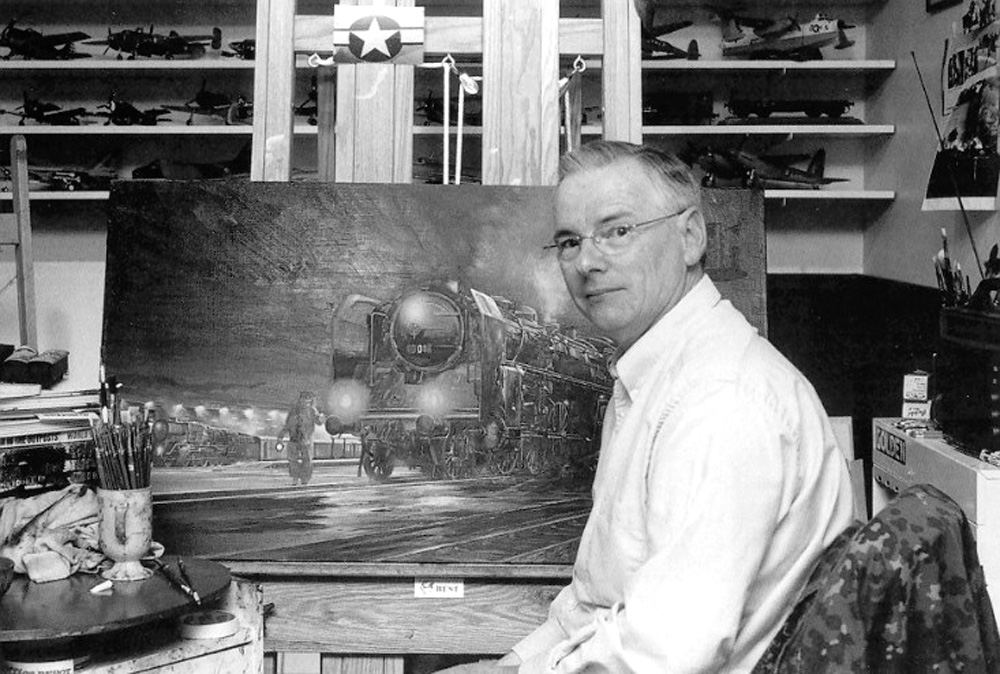By Larry W. Bledsoe
The paintings of aviation artist Robert Bailey reflect his fascination with planes, trains, antique cars and people. Usually landscapes filled with plenty of action, each tells a story of human drama, often in combat.
An artist fellow with the American Society of Aviation Artists and a member of the Canadian Aviation Artists Association, Bailey was born and raised in England, where he later attended College of Art in Stoke-on-Trent, Staffordshire. He then immigrated to North America and now lives in Canada. He says his father’s tales of battles in North Africa and Italy originally inspired his work.
One of those stories resulted in the painting, “Breakthrough at Cassino.” The scene depicts fighters from the 27th Fighter Bomber Group flying over the Italian city of Monte Cassino. The lead plane is a P-40 Warhawk flown by 1st Lt. Ralph Giovanniello; under his left wing is Capt. Robert M. Johnson in his A-36 Apache. Giovanniello and Johnson are two of five 27th FG pilots who have co-signed this print. Below the planes, in the battered city of Monte Cassino, are both American and British tanks preparing for the final battle.
Bailey effectively uses light to showcase the P-40 and A-36, the primary subject matter of this painting, and a Sherman tank in the center foreground. Is it coincidental that the sunlight shining down on the aircraft also hits the spot where the tank sits, or did the artist have another motive for showcasing that tank? He did; it was his father’s tank. Bailey is very proud of his father and was honoring him in this dramatic painting. Incidentally, Trooper James Bailey signed all the artist proofs in the edition.
Robert Bailey uses each scene to elicit different emotions from the viewer. He shows the drama and harsh reality of war in a picturesque story. He uses light to effectively set the mood of the scenes. Whether you’re a war buff or not, you can feel the visual impact this talented artist can impart.
“Mustang Menace” reveals a different aspect of the Mustang’s versatility. It shows P-51 Mustangs from the 357th FG attacking ground targets in eastern France during late August 1944. The lead plane is “Passion Wagon,” flown by 1st Lt. Arval Robertson, who was with the 362nd Fighter Squadron. Robertson and four other 357th FG pilots have signed each print.

Mustang Menace” shows P-51 Mustangs from the 357th Fighter Group attacking ground targets in eastern France during late August 1944.
This fighter group was assigned to the 8th Air Force and made its combat debut on Feb. 11, 1944. Their home base was Leiston, England. By the time they flew their last combat mission on April 25, 1945, they were credited with shooting down 595.5 enemy aircraft. This record, exceeded only by the 56th FG, made them the second-highest scoring 8th Air Force fighter group. Their final score included 19 Me 262s, of which one was credited to Capt. Chuck Yeager.
Another high-scoring fighter group in the European Theater of Operation was the 352nd Fighter Group, which is the subject of Bailey’s print “Bluenose Bounce.” This group ended the war with 504.5 official aerial victories and destroyed another 287 enemy aircraft on the ground.
Fighters of the 8th Air Force attacked German aircraft in the air and on the ground, wherever they could find them. In this scene, the artist shows Lt. Bob “Punchy” Powell leading one such ground attack as the Mustangs from the 352nd FG hit the German airfield at Herbeville, France, on April 28, 1944. Unfortunately, Powell’s wingman, Lt. Jamie Lazing, was shot down during this attack and taken prisoner.
Bailey has also honored the Tuskegee Airmen in a couple of his prints. One of them is “Tuskegee Junction.” The Tuskegee Airmen were proud, dedicated and talented. They were the cream of the crop. They had to be, in order to survive the rigors of training and graduate from the Tuskegee training facility in Alabama. This painting depicts Mustangs of the 302nd FS that have finished their escort duties and were then looking for targets of opportunity.
Since trains were always an important target for fighter pilots, it’s not surprising that these Tuskegee pilots came across a busy Austrian marshalling yard near Vienna. After selecting a train with a long line of box cars, 1st Lt. Charles E. McGee began his strafing run. One or more of those cars carried ammunition that exploded under the hail of 50-caliber bullets from his Mustang’s six guns. The explosion forced the following Mustang to climb clear of the flying debris and shrapnel from the exploding munitions.

Robert Bailey has honored the Tuskegee Airmen in a couple of his prints, including “Tuskegee Junction.”
Part of what makes Bailey’s paintings so popular, in addition to the dramatic story being told, are the signatures of those who participated in these events. Bailey says each painting begins with an idea, followed by contact with a prospective signee who took part in the action to be depicted. After many telephone conversations with the war veteran, and receipt and study of research material, Bailey spends about two months painting the oil-on-canvas. The average size is 30″ x 46″.
Another of Bailey’s prints is “Morning Thunder,” which depicts P-47 Thunderbolts of the 84th Fighter Squadron, 78th Fighter Group attacking a German aerodrome in late 1944. This is one of the few prints that he has done that is not co-signed by participants of the action depicted. However, it’s an intriguing depiction of Thunderbolts in action and representative of the increasing aerial presence of 8th and 9th Air Force fighter planes that became more aggressive over Europe before and after D-Day in 1944.
One of his most recent prints, “America’s Century,” shows the 100th BG’s B-17s coming off the target at Ruhland, Germany, on Sept. 11, 1944. That day they lost 12 crews. The 100th BG had the reputation that few of its crews ever completed 25 missions, the normal tour of duty. Mainly, because many believed that the Luftwaffe had a special vendetta against the group.
However, reading through the group’s history in Edward Jablonski’s “Flying Fortress” provides a better understanding why the group suffered unusually heavy losses in the beginning. They entered combat at a time when the bombers were sent to targets that were beyond the range of fighter escort. They were often assigned the position in the bomber formation that usually suffered the brunt of the Luftwaffe attacks, and their air discipline over enemy territory wasn’t up to expectations. Once fighter escorts were available to and from the target, and under new leadership, their losses weren’t much different than other groups, but their “Bloody Hundredth” reputation stayed with them.
One of the most impressive aspects of Bailey’s work is his effective use of light in telling the story. Even his night scenes are alive and detailed and not overwhelmed by the darkness, which is a difficult balance for any artist to achieve. But more importantly, his paintings are about people and the trauma they lived through, both on the ground and in the air. His paintings help us remember, and honor, those who made a tremendous sacrifice for our freedom.
Larry W. Bledsoe is an avid aviation historian and writer and owner of Bledsoe’s Aviation Art. For more information, visit [http://www.bledsoeavart.com].












